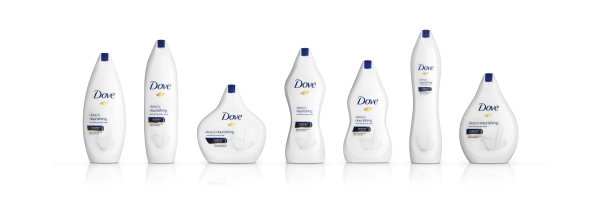
Image source: Dove
The limited edition bottles of Dove U.K body wash released as part of its #RealBeauty campaign contained six shapes of bottles meant to resemble different types of women’s bodies – as opposed to hourglass-shaped models.
Dove, a Unilever-owned brand, stated: “From curvaceous to slender, tall to petite, and whatever your skin colour, shoe size or hair type, beauty comes in a million different shapes and sizes. Our six exclusive bottle designs celebrate this diversity: just like women, we wanted to show that our iconic bottle can come in all shapes and sizes, too.”
But social media users mocked the shapes. Some said the campaign encourages women to be defined by their body shapes. Others said the exaggerated shapes don’t represent real bodies. Media outlets picked up the comments and republished snide remarks from Twitter and Instagram. Media outlets said the bottles were “met with collective groans,” were “hilariously stupid.” Dove had “ruined its body image” or had “gone from empowering to patronizing.”
“People can’t decide if they should be laughing or fuming over Dove’s latest campaign, which features bottles of body wash designed to replicate women’s physique,” sated the Daily Mail.
A Different Social Media Narrative
At that point, you might expect Dove to quickly kill the #RealBeauty campaign, apologize to any offended customers and reiterate its commitment to “celebrating beauty diversity.” That’s the pattern followed by other brands. That’s where the narrative diverged from the standard pattern.
A survey by Morning Consult found that the diverse bottle shapes did not soil Dove’s reputation. Out of 2,200 Americans surveyed, 41% had a more favorable view of Dove after seeing the campaign images. Only 9% retained a less favorable opinion. In addition, 71% said they were likely to purchase Dove products, up 3 percentage points from before seeing the campaign. Forty-one percent of survey respondents said that it made no difference either way.
Consumers are likely to stick to what they know. A third of people indicated they prefer the standard-shaped Dove bottle out of a lineup of the Real Beauty bottles
Lessons Learned
The Dove story illustrates that social media may not always provide an accurate gauge of overall consumer sentiment. Demographics of social media networks and especially frequent posters differ from the general population and a brand’s target audience. Research has shown that social media enthusiasts who post frequently represent a small portion of social media users but generate the bulk of posts. Their shopping habits differ markedly from those of other consumers. People can easily post their reactions, and are especially quick to post criticisms.
Because of those factors, social media listening may produce skewed findings. Combining social media analysis with different types of research is more likely to produce accurate assessments of consumer sentiment.
Social media analysis does offer several advantages over traditional marketing research. It’s fast and affordable. A social media listening service can report data practically instantly. Extensive analysis can generate data in hours or days, as opposed to weeks or months for conventional research methods. At times, social media measurement can be more accurate than conventional market research since consumers are less disposed to mistaken recall and social desirability bias, or giving answers they think are appropriate. Yet, even with all its advantages, analysis of social media sentiment must be used with some caution, lest the vocal minority overwhelm the quiet majority.
Bottom Line: Reactions to Dove’s Real Beauty campaign with its diverse shapes of shampoo bottles illustrate how data from social media listening can be easily misunderstood. While many social media comments panned the campaign, a customer survey found more positive responses. The campaign highlights the need to augment social media analysis with other, offline research to obtain well-rounded and more accurate assessments of consumer sentiment.
William J. Comcowich founded and served as CEO of CyberAlert LLC, the predecessor of Glean.info. He is currently serving as Interim CEO and member of the Board of Directors. Glean.info provides customized media monitoring, media measurement and analytics solutions across all types of traditional and social media.




